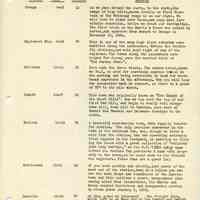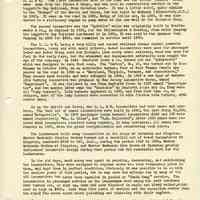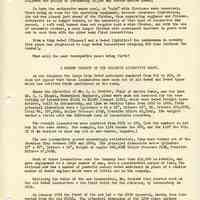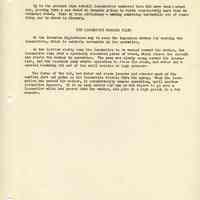Collections Item Detail
Package: railroad excursion by N.Y. Chapter of the Railway & Locomotive Historical Society from Hoboken to Scranton, PA, on the D.L.& W. R.R., July 19, 1936.
2014.013.0114
2014.013
Lukacs, Claire
Gift
Museum Collections. Gift of a friend of the Museum.
1936 - 1936
Date(s) Created: 1936 Date(s): 1936
Notes: Archives 2014.013.0114 ==== [Davis letter] The Delaware, Lackawanna and Western Railroad Company 90 WEST STREET (140 Cedar Street) NEW YORK J. M. DAVIS President July 18, 1936 To Members and Friends of the New York Chapter: When I learned that the members and friends of the New York Chapter of the Railway and Locomotive Historical Society had decided upon an all-day excursion over the eastern section of the Lackawanna, combining a tour of inspection of the Company’s property, it was our desire to perfect arrangements which would make your trip thoroughly enjoyable. As a result of the interest and cooperation of your fellow member, Mr. T.T. Taber, a valued friend and patron of the Company, you are being presented with an outline of the Lackawanna’s history and development. It will become apparent, as your special train traverses the line, that the Lackawanna has been developed intensively during the last thirty years, until it may be considered thoroughly representative of the American railroad system. Members of your Chapter especially interested in terminal operation will find much to demand attention at Scranton, including the several yards and the locomotive and car shops, through which your party will be escorted. The Lackawanna staff is delighted to be the host of your Chapter tomorrow. We hope that your trip will be both instructive and enjoyable. Very truly yours, J. M. Davis, President [end Davis letter] ==== History and tour program [only first six pages transcribed] page [1] The New York Chapter of the Railway & Locomotive Historical Society, Inc. welcomes you on its first trip on the Delaware, Lackawanna & Western Railroad. In line with its aims, of showing the progress and development made by the railroads during the past century, and in keeping with its slogan - "Linking the Past with the Present", the New York Chapter presents to you a historical sketch of the Lackawanna Railroad, and its component parts, representing the historical side of the trip. Your own eyes will show you the high stage of development achieved today on this railroad. The historical facts contained herein are from the extensive collection of a member of the Chapter who has devoted several years of intensive study to the history of the D. L. & W., and the leased lines which today comprise the system. The Officers and members of the Chapter, as well as the Officers and employees of the Lackawanna Railroad, hope that the day will prove both interesting and instructive, and that it will give you a better idea of the complexities of modern railroad operation, and just how far the railroad has developed during the last century. Many persons are not familiar with the fact that for years, the Delaware, Lackawanna and Western Railroad has enjoyed the reputation for being, mile for mile, the most highly developed railroad in the United States, Its commutation service has set a standard by which other railroads serving the metropolitan area are judged. Its handsome, substantial suburban stations are superior to those of any other railroad. For years anthracite was burned in the locomotives, which made the commuters daily trips more pleasant, and now even cleaner, and more frequent service has been provided by the electrification of that service to Montclair, Gladstone and Dover. There is ample justification for the statement that rents and property values in the territory served by the Lackawanna’s commuting service are higher than in other parts of New Jersey. It is not generally realized that the Lackawanna has the shortest, and one of the most scenic lines from New York to Buffalo, It serves a prosperous as well as beautiful territory. Much anthracite originates along its Bloomsburg Division, and is swiftly moved to the seaboard and Great Lakes. As you pass over the Lackawanna of today, note the heavy reinforced concrete bridges, the well kept structures and buildings, and last but not least, the beautifully maintained track and right of way. Much has been done on this railroad during the past hundred years. You may be surprised to know that the Delaware, Lackawanna & Western Railroad, as operated today is not just one railroad, constructed and operated as such. It is made up of a number of lines, built independently and so operated, which thru purchase or long term lease were eventually knit together to form the property as at present operated. If you are making a trip over the present Lackawanna system from New York to Buffalo, you would either pass over, or intersect, the rails of the following companies. Morris and Essex Railroad. Extends from Hoboken to Phillipsburg, N.J. Now used as main line from Hoboken to Port Morris Junction. ==== page 2 Chester Railroad This branch line, which leaves the main line at Chester Junction, four miles west of Dover, originally extended to Chester, but now runs south to Succasunna, New Jersey, only. It was built in 1868 to tap iron mines and gravel pits, and immediately leased to the Morris and Essex for its corporate existence. Passenger service on the branch was discontinued about four years ago. Sussex Railroad You do not travel over this line, which leaves the M. & E. at Netcong and runs northwest thru Newton to Branchville. The Lehigh & Hudson River Railroad operates freight trains from Maybrook, N.Y., over their road, to Andover Junction, and thence (with their own locomotives) to Port Morris yard. Lackawanna Railroad of New Jersey. Known as the "New Jersey Cut-Off", Built in 1911 to provide a shorter line with better grade, from Port Morris Junction, to the Delaware River. Newark & Bloomfield. At Roseville Ave. station (part of Newark) the tracks of the Newark and Bloomfield leave the M, & E, and run to Montclair. New Jersey Westline. Generally known by the later name - Passaic & Delaware Railroad, diverges from the M. & E. at Summit and wander westerly to Gladstone, N. J. Warren Railroad of New Jersey. You do not see this line, unless you follow, as we are doing today, the M. & E., to Washington. The Warren was built to enable the D. L. & W. to run across Now Jersey to connect with the Central Railroad of New Jersey. The D.L. & W, being a Pennsylvania company, could not build under its own name in New Jersey, so it advanced the money for construction of the Warren Railroad, from the Delaware River, to Hampton Junction, N. J. When the M. & E. finally built to Washington, N. J., it crossed over, and connected with the Warren at that point. The Warren never owned or operated any equipment, as it was taken over by the D. L. & W. as soon as completed. Bangor & Portland. This line leaves the old line of the D.L.& W. at Portland, Pa., and wanders thru the hills southwesterly, to Bangor, Bath and Northampton, with a branch to Martine Creek. It was built about 1880, and bought its first locomotive from the Morris & Essex in that year - the old "Madison" No.24, which it renumbered 1, and named "Bangor". It has been a very profitable line as it runs thru a slate and cement region. About 1904 the Lackawanna obtained complete control and have operated it ever since. No passenger service has been run in several years. Delaware, Lackawanna Western. Chartered in the State of Pennsylvania originally as the Leggett’s Gap Railroad, to build from Scranton to state line at Great Bend on the Susquehanna River opposite the present station of Hallstead. It connected with the Erie at Great Bend. The Southem Division, so called, was incorporated to build from Scranton to the Delaware River (where it connected with the Warren Railroad.). ==== page 3 Lackawanna & Bloomsburg. This line now known as the Bloomsburg Division, was bought by the Lackawanna, outright. It extends from Scranton, southerly thru the anthracite fields to Northumberland, Pa. opposite Sunbury, Pa, Much of the anthracite shipped over the Lackawanna, today, is mined along the Bloomsburg Division. Lackawanna & Montrose. This little line leaves the main stem at Alford, Pa,, and extends to Montrose, the picturesque county seat of Montrose County, a distance of about ten miles. Valley Railroad. This company was incorporated in New York to build from the state line, west of Hallstead, Pa,, to Binghampton, N.Y., a distance of about 14 miles. The D.L. & W, operated it. Syracuse, Binghampton & New York. Extends northward from Binghampton to Syracuse, a distance of 80 miles. Had its own equipment so lettered, until 1899. Oswego & Syracuse. Extends from Syracuse, northwest, to Oswego, 35 miles. This line was built to handle coal and other commodities from the D.L. & W., S.B. & N.Y., destined for points on the Great Lakes, and Canada. The original stockholders of this line get a substantial dividend, guaranteed by the D.L. & W. which now operates the line. Utica, Chenango & Susquehanna Valley. Extends from Chenango Forks, 11 miles north of Binghampton, on the S.B. & N.Y., to Utica, 84 miles, with a branch from Richfield Junction to Richfield Springs, 22 miles. The latter town was once a well-known summer resort, to which thru Pullmans were operated from both. Utica and Hoboken. Erie and Central New York. This is a comparatively new line, which extends from Cortland, N.Y. to CincinnatuS, N.Y, It traverses a rich farming and dairy region. It intersects the S.B. & N.Y. at Cortland, The Lackawanna obtained complete control of it about 1902, New York, Lackawanna & Western. This is really one of the newest, or youngest members of the Lackawanna family, as it was not built until 1880, and opened in 1881-2, It extends from Binghampton to Buffalo, a distance of 203 miles. Having a good grade, considerable fast running was done on this division in the old days. This line was built by the D.L. & W., and operated as the Buffalo Division, Very few of the original pieces of equipment were lettered "N.Y.L.& W.", and not for long. Cayuga & Susquehanna. This line which extends from Owego northerly for 35 miles to Ithaca, N.Y, is really the daddy of the Lackawanna system. It was built as the Ithaca and Owego, and celebrated its centennial in 1928- altho [sic] no official recognition of that fact, was taken. ==== page 4 You will be interested to know that prior to the general consolidation of the above mentioned lines, effected by President Truesdale, in 1899, practically all of the lines were operated independently, each having its own motive power and equipment. Its locomotives were designed and built by its own master mechanic, pretty much as he thought best. In May 1899 all locomotives were renumbered into one series, from No, 1 to 999, and the old divisional identity was lost. Incidentally, at that same time, many of the old records which would today be priceless to the historian, were burned up. Today, on our special train, we do not pass over many of the different parts of the Lackawanna, but those over which we do pass are of special interest. From Hoboken we use the tracks of the Morris and Essex Railroad to Washington, N. J., the Warren Railroad from that point to the Delaware River, and the original D. L. & W. from that point to Scranton. It is, indeed, fitting and proper that the New York Chapter of the Railway and Locomotive Historical Society pay tribute to the men who struggled to build the old Morris & Essex, by making a trip over the line, on this, the centennial year of the operation of the first train. That train, probably of one or at most two cars, was pulled by horses from Newark, at Broad and Orange Streets, up the steep hill to Roseville and on to Orange, on November 19, 1836, After leaving Newark, from the point where we pass the coal pockets just west of the station, to about Brick Church, we are following the path of the horses which plodded slowly, one hundred years ago. Think of the progress made in that time! Today speedy electric suburban trains, and heavy steel thru trains hauled by huge locomotives, make short work of the grade from Newark to Roseville. We must admit, however, that the grade has been considerably reduced, since Seth Boyden's little locomotive "Orange" puffed up it in September 1837. The perfection that we have reached today has been possible because of the toil, sweat, and planning of the men who have gone before us. On this centennial of the old Morris & Essex, as you pass over the line, think of what it must have been a hundred years ago! In starting our trip we must mention the ferries, which daily carry thousands of persons and vehicles across the Hudson River. Prior to 1903 they were owned by an independent company, which cooperated with the railroad, but could not provide adequate service, so the boats were purchased along with the franchise which incidentally gives the exclusive right to operate a ferry in the city limits of Hoboken. The Lackawanna has maintained and consistently improved the service since taking over the ferry operations. Incidentally the history of the Hoboken Ferry is well set forth in the very interesting book entitled "THE ROMANCE OF THE HOBOKEN FERRY", by Harry Smith. In February 1905 the old passenger terminal at Hoboken was destroyed by fire. Some temporary buildings were erected, and the construction of a modern terminal started. In August 1907 the present terminal was completed - but it has been improved and extended occasionally right to the present time. A railroad never stops. It must either progress and improve, or rapidly deteriorate. Many of you may wonder why the New York Chapter requested the Lackawanna to assign one of the old 4-6-0 camelback locomotives to our train, instead of one of the modern 4-6-2 or even 4-8-4 variety. The reason is just this. The modern 4-6-2 and 4-8-4 will be in service for many more years, whereas the thirty year old 4-6-0 locomotives will soon all be merely a memory* Therefore, it is much more to the point that you should have a ride behind a locomotive which has been retired from main line service, and may be scrapped any time- that being the end of that type of locomotive- than for you to, this year be pulled by a locomotive that you may be reasonably sure will be ready to haul you five years from now. ==== page 5 At this point we want to call your attention to the dining car - which is preparing to serve you. A modern dining car, fully equipped costs several thousands of dollars. You will find Lackawanna dining service all that you could expect. It is suggested that you have lunch not later than leaving Stroudsburg, so as to be ready for the program arranged on arrival at Scranton. For dinner on the return, you have all of the time you could possibly use! To make your trip more interesting, and to provide you with something which will be of value, both as a memento of your trip over the Lackawanna, and historically, or for reference, the following outline of your trip contains the high spots, and much interesting information about the railroad and points of interest along it. As the information is accurate you may use it for future reference. Station Approximate Passing Time Distance from Hoboken app. Remarks Hoboken, N.J. Leave 9-30 00 1.00 As we pull out of the yards, the roundhouse, and electric shed is on the right. The huge freight warehouse can be seen on the left, just beyond the junction with the freight tracks. There are two tunnels thru Bergen Hill (about 3/4 mi. long). The old (north) tunnel was built in 1877. Prior to that time the trains used the old Erie tunnel, from 1863, when the line across the meadows, from Newark, was built. Prior to that, the cars of the M.& E. were pulled by the N.J.R.R.& T. Co. (now Pennsylvania) from Newark to their station at Jersey City. West End Junction 9-35 The Boonton Branch, operated by steam, and over which the freight is handled, diverges to the north. The freight roundhouse is at Secaucus, about two miles north. The 1600 (4-8-4) and 2200 ( 3 cyl.4-8-2) class locomotives are used for thru freight. Newark Stop 9-45 The Morris and Essex originally had its terminal at Broad and Orange Streets,a block south of the present tracks. In 1903 the line was changed, when new station was built and tracks elevated. Roseville Ave. 9-49 9 Originally known as "Bloomfield Junction." The line to Montclair diverges to the north. The locomotive is grunting because of the grade- 61' to the mile, but the old original grade was about 140' to the mile, so it should not complain too much. It has worse grades ahead. ==== page 6 Station Passing Time Hoboken Remarks Orange 9-53 12 As we pass around the curve, to the south,the range of high hills,known locally as First Mountain of the Watchung range is on our right. We will have to climb over those,and many more formidable mountains, before we reach our destination. The first train on the Morris & Essex was pulled by horses,and operated from Newark to Orange on November 19, 1836. Maplewood Stop 9-58 15 This is one of the many high class suburban communities along the Lackawanna. Notice the beautiful stations,and well kept right of way of the railroad. The towns along the Lackawanna have helped New Jersey earn its merited title of "The Garden State". Millburn 10-01 17 Here ends the three tracks. The center track,known as No.1, is used for eastbound express trains in the morning and being reversible is used for westbound expresses in the afternoon. Now you will hear the locomotive bark in earnest, as there is a grade of 80' to the mile ahead. Summit 10-07 20 This town was originally known as "The Summit of the Short Hills". Now we tip over the top of our first bad hill, and begin to really roll along-down hill, down hill to Chatham. Just west of Summit the Passaic and Delaware diverges to the south. Madison 10-16 26 A beautiful residential town, with equally beautiful station. The only peculiar character in the town is the railroad fan, who, though he lives a mile from the station, has two operating automatic block signals in his backyard, in addition to filling the house with a great collection of "railroad junk heap salvage," as the N.Y. TIMES aptly described it. Another fan purchased a home with property to the track,so he could wave to his friends the engineers. These fans are a queer lot! Morristown 10-21 30 If you look quickly and closely,just north of the west end of the station,down in a hollow you can see the main shops and roundhouse of the Morristown and Erie railroad a short, independent line owning about four locomotives. The Morris and Essex reached Morristown and inaugurated service by steam power January 2, 1838. Denville 10-31 36 At this point we intersect the freight line, which left us at West End of the tunnel,and passed thru Passaic, Paterson and Boonton. There are no grades of consequence on that line, so all thru freight moves over it. The original Morris and Essex passed thru Rock away,but we follow the newer line which is shorter. At East Dover Jet. the line from Rockaway comes in from the right. [end page 6] ==== [end of transcribed pages] Status: OK Status By: dw Status Date: 2014-11-11



![Program, pg [1]](https://d3f1jyudfg58oi.cloudfront.net/11047/image/81587360-fb26-11ed-a641-b3912f9925a9-uFif2T0.tn.jpg)














![pg 17 [end history and program]](https://d3f1jyudfg58oi.cloudfront.net/11047/image/933f1f70-fb26-11ed-a641-b3912f9925a9-uFifaTk.tn.jpg)






